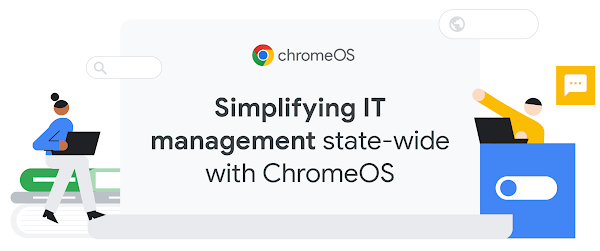Editor’s note: Today’s post is by Daniel Zeiger, Director of Information Technology for Georgia Public Library Service in Atlanta. Georgia Public Library Service provides consulting services and technical assistance to libraries, such as resource sharing, outreach support, and facilities planning for Georgia’s 407 public libraries, as well as scalable library technology and services, grant administration, and more to create equity in library experience for patrons, no matter where they live. Georgia Public Library Service uses ChromeOS devices as loaner devices for patrons, internet use stations within the library, and as a platform for digital signage and kiosks.
As patrons return to their local libraries across Georgia, we’re asking ourselves how best to serve them now and in the future. As we learned over the past couple of years, people really want and need more access to WiFi and devices so they can do research in the libraries and at home. Our libraries are also offering more in-person events, which means we need digital signage displays to keep patrons up-to-date on programming schedules.
At the same time, our agency has to consider how more technology-related services will impact library staff. While libraries in big cities have large IT teams, smaller ones might not have anyone to manage the tech. We don’t want to burden busy librarians and admins with technology troubleshooting at a time when serving patrons is paramount.
With ChromeOS devices in our libraries, we can meet patrons’ need for online access, and our desire to offer community events, without adding a long list of tech support tasks to staff’s to-do lists.
Taking the guesswork out of software updates and digital signage
Georgia Public Library Service offers consulting and technical services to the state’s libraries. We’re not here to dictate the technology libraries have to use; we’re here to help them understand the options that are available within their budgets.
In early 2020 we offered ChromeOS devices to libraries for assistance with the U.S. Census so we already knew how easy ChromeOS was to manage. When schools had to switch to remote learning, the ChromeOS device program went into high gear because managing Chromebooks in the Admin console didn’t require a full IT staff. Libraries could loan out Chromebooks without worrying about keeping them updated with software, while also maintaining patrons’ privacy and security.
The ChromeOS devices also run about 120 digital signage displays at 49+ branches. In the Admin console, library staff can simply point Chromeboxes to a particular Google Slides file and share it with their coworkers. It takes all of the guesswork out of the process. As more people come back to libraries and more events are scheduled, the digital signage setups keep patrons informed about what’s coming. Digital signage is used in the library to show everything from hours and policy changes, to upcoming programming.
Taking IT management off of busy staff’s to-do list
Eighteen percent of Georgia’s library systems only have one or two locations and perhaps only about 25 Chromebooks for patrons to borrow or use in the library. Some of these smaller locations have no IT team, and the library system’s director is the ad hoc IT person.
Even with limited IT resources these loaner Chromebooks have run almost three years, syncing and updating, without a single support ticket. We’ve seen similar trouble-free operations all over the state since we started using ChromeOS devices in 2013. ChromeOS takes that work off their plates, so the library staff can focus on providing services the way they want to. The real time savings has been at the library level, where employees helping out with IT tasks were spending huge chunks of time managing software updates and troubleshooting public access machines. With ChromeOS, employees now install devices and walk away from all that maintenance. ChromeOS devices use about one-third less power than traditional desktop computers. Since we’re saving money, libraries can afford to replace old CRT monitors with new LED monitors, adding another layer of savings.
One of the great features of the Admin console is that library staff can look at other library configurations, approved links, apps, and much more. The staff can simply copy Admin console settings from similar working configurations, and they’re done. In addition, many branches are using ChromeOS devices in kiosk mode so patrons can look up books in the catalog.
We now have over 5,000 ChromeOS devices at our libraries or on loan to patrons. At the height of the pandemic in 2020, when some of the libraries were still closed, emergency ChromeOS devices were purchased and loaned directly to students and patrons who borrowed them long-term. Buying, enrolling, and delivering these devices was handled by our partner, CDW Government, so all of the Chromebooks and Chromeboxes were pre-enrolled and ready to manage in the Google Admin console.
A powerful outcome: more time to devote to patrons
From the Chromeboxes used for digital signage to the Chromebooks out on loan, the devices are getting thumbs-up for ease of use from patrons and staff. When library staff spend a couple of months seeing how easy it is to manage ChromeOS devices in the Google Admin console, or to create and post digital signage content, they realize how much time they can free up in a day.
Technology like ChromeOS touches so much of our daily lives in our libraries. The biggest transformation is the amount of time saved that can be refocused on patron service. Providing access to online services is no longer a burden. That’s a very powerful outcome.
Cloud BlogRead More


